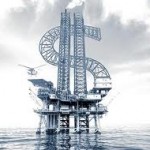 The Energy Alternatives: Extreme Petroleum
The Energy Alternatives: Extreme Petroleum
By S. Thomas Bond, Lewis County, WV
PART I
We all know “the easy stuff is gone” when it comes to fossil fuels (and many other resources as well). Let’s take a closer look at the extremes the human race is using to get oil and gas. Companies are taking greater and greater risk to recover increasingly valuable petroleum. Engineering advances toward the breaking point.
The latest news is the failure of Royal Dutch Shell PLC’s containment dome intended for use in the waters north of Alaska. It was “crushed like a beer can,” said the Huffington Post. The test was done in calm waters under predictable test conditions, in Puget Sound near Bellingham, Washington. The dome obviously will have to be able to withstand ice floes in gusty winds, not to mention Arctic temperatures.
The plan is to stop drilling these arctic wells in the fall and wait until it warms up in the spring to start up again to continue working on them. The New York Times ran an article discussing the failure and stated the federal government hads already provided most of the regulatory approvals Shell need to drill in the Arctic. Shell has postponed its plan to drill until next year. The wells are tens of miles offshore. Twenty two ships and $4.5 billion investment are involved in one plan at this point.
A few months ago Christophe de Margerie, CEO of Total SA (the fourth largest publicly-traded oil and gas company in the world), told reporters the risk of a potentially devastating oil spill was too high and that a leak would do too much damage to the image of the company. He told the Financial Times that these Arctic operations could be a disaster and warned other companies against it.
PART II
This author has written before about the ultra deep drilling off Brazil’s shore. Over 7000 feet to the ocean floor, nearly 10,000 feet through rock, then another 7000 feet of salt, and there you find oil. 6.5 billion barrels in the Lula field. Other Brazilian fields bring the total to 13 billion – projected. As The Economist of London puts it, ” —if all continues to go well.”
“That is a big “if”. These ultra-deep deposits must be drilled at up to three times the normal pressure for offshore oil. The salt often shifts and closes up after drilling. Some of the chemicals in the oil are highly corrosive. And the distant fields are hard to reach, for both people and pipelines,” The Economist article continues.
The technology requires floating drilling rigs which must compensate for waves and tide. In 2004 BP’s Algodoal-1 exploratory well was drilled in 2545 feet of ocean water to a total depth of 3.5 miles approximately 200 miles off the northern coast of Brazil with the drillship Jack Ryan. This well had severe well bore ballooning (loss of drilling mud with pumps on and gaining lost mud with pumps off) at several levels. Care had to be exercised to make sure it was the strata pushing back, not gas. The well was planned with nine strings of casing
The politics of Brazilian drilling are not what big oil wants, either. The government insists that Petrobras, its national oil company, be the sole sub-salt operator and make up at least 30% of any consortium. The source of most goods and services must be within Brazil. More here.
A year ago December 2011, the country’s prosecutors filed a $10.6 billion lawsuit against Chevron and Transocean for environmental damage caused by an oil spill in November in the Campos Basin, off the southern coastal state of Rio de Janeiro. Recently that suit has been dismissed.
Petrobas got a $2 billion from the US in a loan. This was supported by Pres Obama on his South American tour last year saying that his administration wants to assist the Brazilian government “with technology and support” in developing its oil reserves — a black gold mine he said could hold twice as much oil as U.S. deposits. ”And when you’re ready to start selling, we want to be one of your best customers,” he said. Which statement upset the drilling industry and caused Fox News to erupt.
PART III
Remember BP’s Macondo well? In addition to the human loss, there was three months of environmental terror, a cleanup that still isn’t over, and endless ads on nightly news even today about how good things are again in the Gulf of Mexico.
At one point it became clear to the careful reader that the real fear was that the drilling had opened a channel from the ocean bottom all the way down to the oil reservoir OUTSIDE the DRILL PIPE. Such an opening could not be closed off with any technology known. The consequence of this would be that the entire reservoir would drain up into the ocean and drift any where ever the currents would take it. Millions of barrels coming up for decades.
The effect on the world’s oceans and shores would be staggering because it would go everywhere. This could happen elsewhere, too.
PARTS IV thru X are to follow in the next few days.
